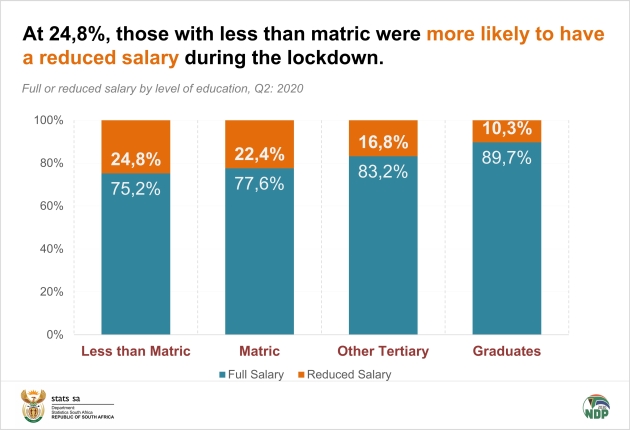29 September 2020
The South African economy shed 2,2 million jobs in the second quarter of 2020, according to the latest Quarterly Labour Force Survey Quarter 2: 2020 results, released by Statistics South Africa on 29 September 2020.

The results indicate that the number of employed persons decreased by 2,2 million to 14,1 million in the 2nd quarter of 2020 compared to the 1st quarter of 2020. This unprecedented change is the largest quarter 1 to quarter 2 decline since the survey began in 2008. Contrary to what one would expect in the face of such a large decline in employment, the number of unemployed persons declined substantially as well – by 2,8 million – to 4,3 million compared to Q1: 2020. In spite of this massive decline in employment, the number of discouraged work-seekers, like the number of unemployed, decreased by 447 000. The majority of those who moved out of these three categories moved into the category of not economically active for reasons other than discouragement, which increased by 5,6 million between the two quarters.

The official unemployment rate is calculated using the number of persons who are employed and unemployed, and does not include discouraged work seekers. The significant changes in the number of persons in these two categories resulted in a significant decrease of 6,8 percentage points in the official unemployment rate from 30,1% in quarter 1:2020 to 23,3% in quarter 2:2020. This is lowest rate recorded since quarter 3:2009.
However, the expanded unemployment rate increased by 2,3 percentage points in Q2:2020 compared to Q1:2020, reflective of the fact that people were available for work but did not actively look for work. The unemployment rate according to the expanded definition increased in all provinces except in the Free State, where it decreased by 3,3 percentage points. The largest increase was recorded in the Northern Cape (up by 5,1 percentage points), followed by the Eastern Cape (up by 3,9 percentage points). When asked why they did not look for work, most people cited the national lockdown / COVID-19 / coronavirus as the main reason for not actively looking for work.
This phenomena of a greater increase in inactivity than in unemployment is not unique to South Africa. It has been observed in most countries across the globe, with the exception of Canada and the United States, according to the ILO Monitor: COVID-19 and the world of work, sixth edition.
To capture changes brought about by the national lockdown, some additional questions were included in the quarter 2:2020 questionnaire. Respondents were asked if they were working from their usual place of work or working from home; whether they continued to receive salaries during lockdown; whether they received full or reduced salary; whether they would be returning to the same job/business after the lockdown; and whether they thought they might lose their jobs or their businesses would close in a foreseeable future due to COVID-19.
Of the 14,2 million persons who were employed in Q2: 2020, more than half (58,1%) were expected to work during the national lockdown by the companies/organisations they work for. There were 173 000 employed persons who were expected to work during the national lockdown but could not do any work during that period. About 76,3% cited the national lockdown as the main reason for not actually working while the rest indicated that they did not work due to health reasons (10,2%); family responsibility (3,5%); or shift work arrangements (10,0%).
Prior to the national lockdown, working from home was not a common practice in South Africa, although the proportion is not known. Although most of those who actually worked during the national lockdown did so from their usual place of work, about 17,6% indicated that they worked from home. The proportion of those who worked from home was higher in Gauteng and Western Cape than in the other provinces. The share of those who worked from home was higher among professionals (44,7%) and Managers (40,6%) indicating access to tools of trade to facilitate work from home for these workers.

There were 11,5 million employed persons who continued to receive pay during the lockdown. About one in five of the employed had a reduction in their pay/salary during the lockdown. There seems to be some relationship between the level of education and reduction in pay/salary. Those with higher levels of education had higher chances of receiving a full salary than those with lower levels of education. Almost 9 in every 10 employed graduates (89,7%) continued to receive a full salary, compared to 75,2% of those with less than matric as their highest level of education.
Those who were employed during the national lockdown were also asked if they will be returning to the same job after lockdown and 94,5% indicated that they will; 2,0% indicated that they will not return to the same job; and 3,5% were not sure. Those who were not returning to the same job or were not sure, were also asked if they thought they might lose their jobs or close their business in the four weeks succeeding the survey interview due to COVID-19. 25,9% indicated that they thought they would.
Due to the lockdown restrictions, data was collected telephonically, unlike the usual face-to-face interviews. As such, data could not be collected from the full sample but only from households for which contact numbers were available. This introduced bias to the sample. These were adjusted for and the details on how the adjustment was done are contained the report.
For more information, download the full report here.
ILO Monitor: COVID-19 and the world of work, sixth edition:
https://www.ilo.org/global/topics/coronavirus/impacts-and-responses/WCMS_755910/lang–de/index.htm

